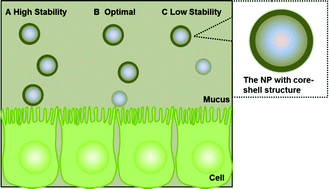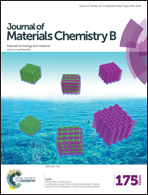Core–shell stability of nanoparticles plays an important role for overcoming the intestinal mucus and epithelium barrier†
Abstract
The hydrophilic and electro-neutral surfaces of nanoparticles (NPs) were generally reported to facilitate their intestinal mucus penetration. Meanwhile, this surface property may prevent the epithelial uptake of NPs by reducing their affinity with the target cell membrane. Our group previously reported a core–shell structure of NPs, in which a “mucus-inert” hydrophilic coating of N-(2-hydroxypropyl)methacrylamidecopolymer (pHPMA) facilitated the mucus permeation of the trimethyl chitosan NP core. Therefore, the NP core could subsequently promote the paracellular transport of payload across the epithelium. However, the relationship between the stability of the core–shell structure and optimal delivery efficacy of the NPs was yet to be established. Herein, an investigation was performed in the present study by using a series of HPMA copolymer coatings with different molecular weight (Mw, 17 kDa to 120 kDa). A correlation was observed between the Mw of HPMA copolymers and the performance of the NPs. Interestingly, the hydrophilic coating hindered the epithelial uptake of NPs for those with higher core–shell stability. On the contrary, lower stability resulted in premature disassociation of the “mucus-inert” shell and trapping of the NP core in mucus. The optimal Mw of the shell polymer was found to be 26 kDa. To further verify the observations, a targeting ligand was introduced by conjugation on either the shell or core of the NPs. Surprisingly, the optimal NPs, modified with a ligand on the core, showed the highest bioavailability of 10.1%, which was higher than NPs with ligands modified on the shell. To the best of our knowledge, our study is the first to discuss the effect of Mw of the HPMA copolymers as a “mucus-inert” material, and might shed light on the rational design of the core–shell NP for overcoming the intestinal absorption barrier.


 Please wait while we load your content...
Please wait while we load your content...